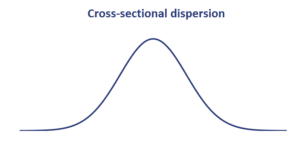Cross-sectional Dispersion
Cross-sectional dispersion in stock markets is a very important concept for active investors. As the name suggests, cross-sectional stock return dispersion looks at how dispersed the returns of securities are. A high level of dispersion has important implications for the performance of active managers. In particular, higher levels of dispersion generally create higher opportunities for stronger active performance.
In the rest of the article, we explain the concept of cross-sectional stock dispersion, explain why it is important for fund managers, and show how it can be used to improve a portfolio’s performance.
Cross-sectional dispersion definition
First, let’s define cross-sectional stock dispersion. Simply put, cross-sectional dispersion is the distribution of the returns of all securities over a given period. Thus, instead of looking at the distribution of the returns of a single security over time, we look at the distribution of the returns of all the stocks over a certain period. The following figure plots what the cross-sectional dispersion may look like this:
The higher the dispersion, the more dispersed the returns of the stocks in the stock market. This means that some of the stocks will have strongly negative returns, while others may have had considerably positive returns.
In such an environment, stock picking matters a lot. Thus, the selection effect plays an important role in funds’ performance. To understand this, let’s assume an environment of low dispersion. In such an environment, the returns on all the stocks are close together. If that’s the case, it did not really matter which stocks the active manager picked, since they all exhibited similar returns. The opposite holds in the case of higher dispersion.
Cross-sectional dispersion portfolio performance
In the introduction we mentioned that dispersion can be used to improve a portfolio’s performance. The approach is quite simple. In periods when cross-sectional dispersion is expected to be (or remain) low, it does not make sense to take much active risk. In such an environment, it is not a good idea to allocate money to stock pickers. If, however, investors expect dispersion to go up, then more active risk should be taken.
Summary
We discussed cross-sectional stock return dispersion. It can easily be calculated using historical stock return data for the stocks in a benchmark or the stocks traded on an exchange. The higher the dispersion, the higher the likely returns from stock picking.

